Chemical Storage Safety Labels
Labels informing laboratory personnel of chemical storage methods can be found here.
- Buffer Solution (2.63″ X 1″)

- In the case of buffer solutions, it is appropriate to identify the contents as “Buffer Solution” and include the type of buffer in its abbreviated form. For example: “Buffer Solution – Tris.”
 Carcinogen Storage (3.5″ X 5″)
Carcinogen Storage (3.5″ X 5″)- A dedicated lockable storage cabinet in a “designated area” is the preferred storage method for carcinogenic chemicals. Cabinets where chemical carcinogens are being stored must be posted with signs or labels bearing the legend: CAUTION – SELECT CARCINOGEN, Use by Authorized Personnel Only. Stock quantities of chemical carcinogens are to be stored in designated storage areas. The storage areas are to be posted with signs bearing the legend CAUTION – SELECT CARCINOGEN Autorized Personnel Only.
- Carcinogen Vessel (2.63″ X 1″)

- Storage vessels containing stock quantities are to be labeled: CAUTION – SELECT CARCINOGEN. Storage vessels containing working quantities should be labeled: CAUTION – SELECT CARCINOGEN. The outer container is to be labeled with both the name of the chemical carcinogen and the warning: CAUTION – SELECT CARCINOGEN.
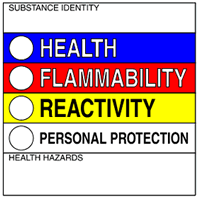 HMIS (2.75″ X 2.75″)
HMIS (2.75″ X 2.75″)- The National Paint & Coatings Association, Inc. (NPCA) developed the Hazardous Materials Identification System (HMIS®) to aid employers in the implementation of an effective Hazard Communication Program. HMIS® Hazard Assessment helps define the Health, Flammability and Reactivity Hazards of different chemicals, and shows how to communicate those hazards with a label that incorporates color-coded fields, along with a recommendation for personal protective equipment. HMIS Hazardous Materials Identification System
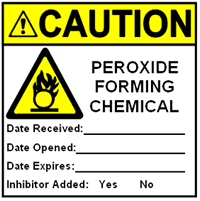 Peroxides (2.75″ X 2.75″)
Peroxides (2.75″ X 2.75″)- To prevent accidents caused by peroxidizable compounds, laboratory safety procedures should emphasize: Use of warning labels. If List B material give a significantly positive test (red by the ferrous thiocyanate test), but must be retained, it must be treated to remove peroxide, repackaged, shown by test to be free of peroxide, and then re-dated on its label. Uninhibited List C materials can be a significant hazard. For storage in excess of 24 hours, a suitable inhibitor should be added, and its name and quantity should be placed on the label. In addition, each container of peroxide-forming chemicals must have the following dates written on the label: Date Received / Date Opened / Date Expires.
 Peroxides Small (2.63″ X 1″)
Peroxides Small (2.63″ X 1″)- To prevent accidents caused by peroxidizable compounds, laboratory safety procedures should emphasize the use of warning labels. Each container of peroxide-forming chemicals must have the following dates written on the label: Date Received / Date Opened / Date Expires.
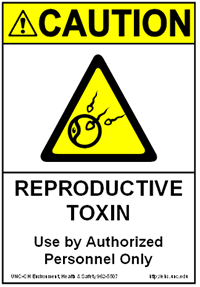 Reproductive Toxin Storage (3.5″ X 5″)
Reproductive Toxin Storage (3.5″ X 5″)- Stock quantities of reproductive toxins are to be stored in designated storage areas. The storage areas are to be posted with signs bearing the legend CAUTION – REPRODUCTIVE TOXIN Authorized Personnel Only.
 Reproductive Toxin Vessel (2.63″ X 1″)
Reproductive Toxin Vessel (2.63″ X 1″)- The outer container is to be labeled with both the name of the chemical and the warning: CAUTION – REPRODUCTIVE TOXIN. Storage vessels containing stock quantities are to be labeled: CAUTION – REPRODUCTIVE TOXIN. Storage vessesls containing working quantities should be labeled: CAUTION – REPRODUCTIVE TOXIN.
- Store No Chemicals (5″ X 3.5″)
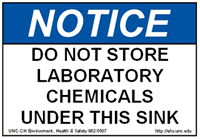
- Cabinets under hoods and laboratory benches can be used for storage of chemicals. However, storage near or under sinks where there may be exposure to water is to be avoided.
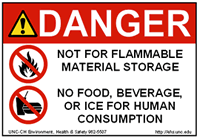 Store No Flammables/Food (5″ X 3.5″)
Store No Flammables/Food (5″ X 3.5″)- Flammable solvents that require storage at reduced temperatures are to be stored only in refrigerators or freezers designed for the storage of flammable liquids. “Safety” refrigerators for flammable liquid storage and “explosion-proof” refrigerators are both acceptable. Ordinary household refrigerators are not to be used for the storage of flammable liquids because of interior arcing contacts. Because there is no venting of the interior spaces in refrigerators and freezers, all chemicals should have tightly sealed caps. Signs should be applied to the doors of chemical refrigerators stating: NO FOOD, BEVERAGE, OR ICE FOR HUMAN CONSUMPTION”.
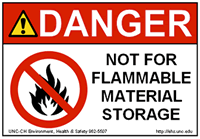 Store No Flammables (5″ X 3.5″)
Store No Flammables (5″ X 3.5″)- Flammable solvents that require storage at reduced temperature are to be stored only in refrigerators or freezers designed for the storage of flammable liquids. “Safety” refrigerators for flammable liquid storage and “explosion-proof” refrigerators are both acceptable. Ordinary household refrigerators are not to be used for the storage of flammable liquids because of interior arcing contacts. Because there is no venting of the interior spaces in refrigerators and freezers, all chemicals should have tightly sealed caps.
 Toxic Chemical Storage (3.5″ X 5″)
Toxic Chemical Storage (3.5″ X 5″)- A dedicated lockable storage cabinet in a “designated area” is the preferred storage method for highly toxic chemicals. Cabinets where highly toxic chemicals are being stored must be posted with signs or labels bearing the legend: CAUTION – HIGHLY TOXIC CHEMICAL, Use by Authorized Personnel Only. Stock quantities of highly toxic chemicals are to be stored in designated storage areas. The storage areas are to be posted with signs bearing the legend: CAUTION – HIGHLY TOXIC CHEMICAL Authorized Personnel Only.
 Toxic Chemical Vessel (2.63″ X 1″)
Toxic Chemical Vessel (2.63″ X 1″)- Storage vessels containing stock quantities are to be labeled: CAUTION – HIGHLY TOXIC CHEMICAL. Storage vessels containing working quantities should be labeled: CAUTION – HIGHLY TOXIC CHEMICAL. The outer container is to be labeled with both the name of the highly toxic chemical and labeled: CAUTION – HIGHLY TOXIC CHEMICAL.
 Hydrogen Gas Storage (5″ X 3.5″)
Hydrogen Gas Storage (5″ X 3.5″)- Post all hydrogen storage and usage locations with permanent placards that read: “HYDROGEN – FLAMMABLE GAS – NO SMOKING – NO OPEN FLAMES.” Gas cylinders must be in an upright position and clamped securely at all times. Because of the extreme hazards created by using certain cylinders in a horizontal position (e.g., acetylene), you must consult EHS before using cylinders in any position other than vertical, with the valve up.
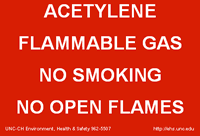 Acetylene Gas Storage (5″ X 3.5″)
Acetylene Gas Storage (5″ X 3.5″)- Post all acetylene storage and usage locations with permanent placards that read: “ACETYLENE – FLAMMABLE GAS – NO SMOKING – NO OPEN FLAMES.” Gas cylinders must be in an upright position and clamped securely at all times. Because of the extreme hazards created by using certain cylinders in a horizontal position (e.g., acetylene), you must consult EHS before using cylinders in any position other than vertical, with the valve up.
